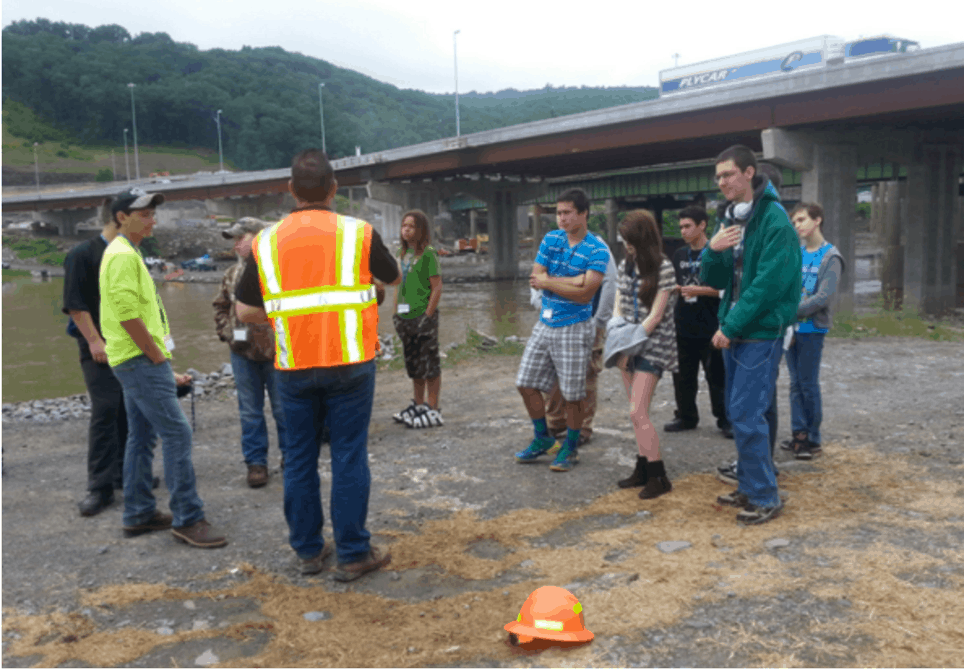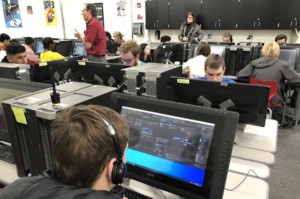Students and Employers Benefit in Real World PBL

By Dawne Adams and Robin Willner
The Pathways in Technology Early College High School (P-TECH) 9-14 model launched in Brooklyn, New York in 2011. Serving every region and major industry in New York State with 38 schools for fall 2016, it re-imagines the pathway for students to complete their first college degree and step into a middle career.
From the first, PBL has been a critical program element for P-TECH, offering students the opportunity to master professional skills for the workplace while assuring that every student, regardless of their academic preparation, will master rigorous academic and technical skills.
As P-TECH scales, school leaders and their employer partners are pushing PBL to a new level that motivates students and generates community support with Workplace Challenges. These challenges offer students authentic problems to solve, define the relevance of their studies and inspire them with the opportunity to make change.
What is a Workplace Challenge?
The defining attribute is the source of the problem that students will address. Employer partners, who are key stakeholders and equal partners in each P-TECH 9-14 school, identify an issue currently facing the company. Once faculty have polished the question into a PBL format, highlighting the professional, academic and technical skills for students to exercise, small groups of students receive their assignment from the employer.
Students work together over 6-8 weeks to address the challenge, supported by teachers and in some cases with additional meetings with the employer or other experts. Upon completion, students present their solutions to the employer or a team of employees, engage in dialogue and receive feedback on their approach. Students learn the implications for a specific industry and establishment and the potential they have to shape a solution that will be implemented in the community. Regardless of the skill and creativity of an expert teacher, no classroom scenario can have the power of an authentic problem presented by an employer who will implement a solution. And no school-based jury will motivate students to produce the quality proposals and presentations that the employers expect.
In Binghamton at the Southern Tier P-TECH, students in the Engineering Technology Pathway worked with Delta Engineers & Architect to present proposals for a pedestrian walkway to be built in a neighboring city as part of an actual bid. Students received the specifications and were tasked with creating a complete proposal–calculation of material costs, timelines, renderings of the design and suggestions for add-ons such as solar lighting, benches and signage.
Teams of students presented their proposals to Delta engineers, who asked about the process, design and future recommendations. The engineers were overwhelmed with the professionalism and quality of the final products and specific student recommendations will be incorporated into the bid. If successful, Delta will involve the students in the next phase of the project.
Another example sprang from a meeting between Southern Tier P-TECH students and their local Assemblywoman, Donna Lupardo, who was seeking their view of the local community in hopes of addressing issues surrounding poverty. By the end of the conversation, they organically arrived at the idea of documenting their view via photo essay. Students set out on several occasions with cameras in hand to capture images representing Pride, Hope and Despair.
Thousands of photos were taken, cataloged, curated, and printed as a body of work featuring 44 examples that best represented the students’ views, showcased at a local Gallery and then at the City Hall Art Gallery. The entire process helped students hone professional skills–collaboration, public speaking, information management and self-promotion–along with technical expertise with various software.
Benefits of Workplace Challenges for Students and Employers
As with any PBL, the design and preparation stages of a Workplace Challenge can be daunting, with the added challenge of partnering with employers. However, the critical concern is professional development for teachers AND students. The latter is too often overlooked. PBL does not come naturally to students, particularly those who enter high school after nine years of traditional schooling. An intentional, graduated approach for both students and faculty assures that students gain confidence and trust in their teachers and in themselves and realize the value they bring to the employer partners with their ideas.
Workplace Challenges are designed to provide the opportunity for students to develop, practice and demonstrate academic, technical and professional skills. They also offer exposure to jobs, careers and working adults. These challenges demonstrate the relevance of academic instruction and offer students the opportunity to have a positive impact and see their solutions implemented. “I finally get the math we have been working on all year. Now that I know how I will use it, it all makes more sense.”
In addition to the host of benefits for students, this enhanced PBL also provides benefits for employer partners and community organizations that in turn provide additional support and resources for public schools. This virtuous cycle begins as employers engage with students, particularly those previously seen as unprepared or unmotivated, and see their potential and input first hand. A common refrain from employers is:
“I don’t expect 16-year-olds to solve my problems. But my senior staff meets each month and proposes the same, tired approach. I know these young people will bring a new perspective AND at least one or two of the groups will offer a solution that is worth exploring or an approach that we can refine.”
The goal of education is not to create exceptional students, but to create exceptional adults with careers that will help them be self-sufficient and contribute to society as a whole while flourishing in their personal lives. PBL provides the experience and training for students to become exceptional and meet the demands of whichever field they choose. They will quickly rise above their peers, who had more traditional education.
For employers, our students become valuable partners and co-creators. The schools they attend emerge as rich resources in the community, offering direct benefits to students and participating companies and long term growth for all.
This blog is part of “It’s a Project-Based World” series. To learn more and contribute a guest post for the series, see the Project-Based World page. Join in the conversation at #projectbased.
For more, see:
- It’s a Project-Based World
- Is it a Project or an Activity? Project-Based Learning and its Cousins
- 3 Elements of Deeper Project-Based Learning
Dawne Adams is a P-TECH Coordinator for Binghamton City Schools (@ptech_st) and Robin Willner is Director at NYS P-TECH Leadership Council.
Stay in-the-know with all things EdTech and innovations in learning by signing up to receive the weekly Smart Update.




0 Comments
Leave a Comment
Your email address will not be published. All fields are required.